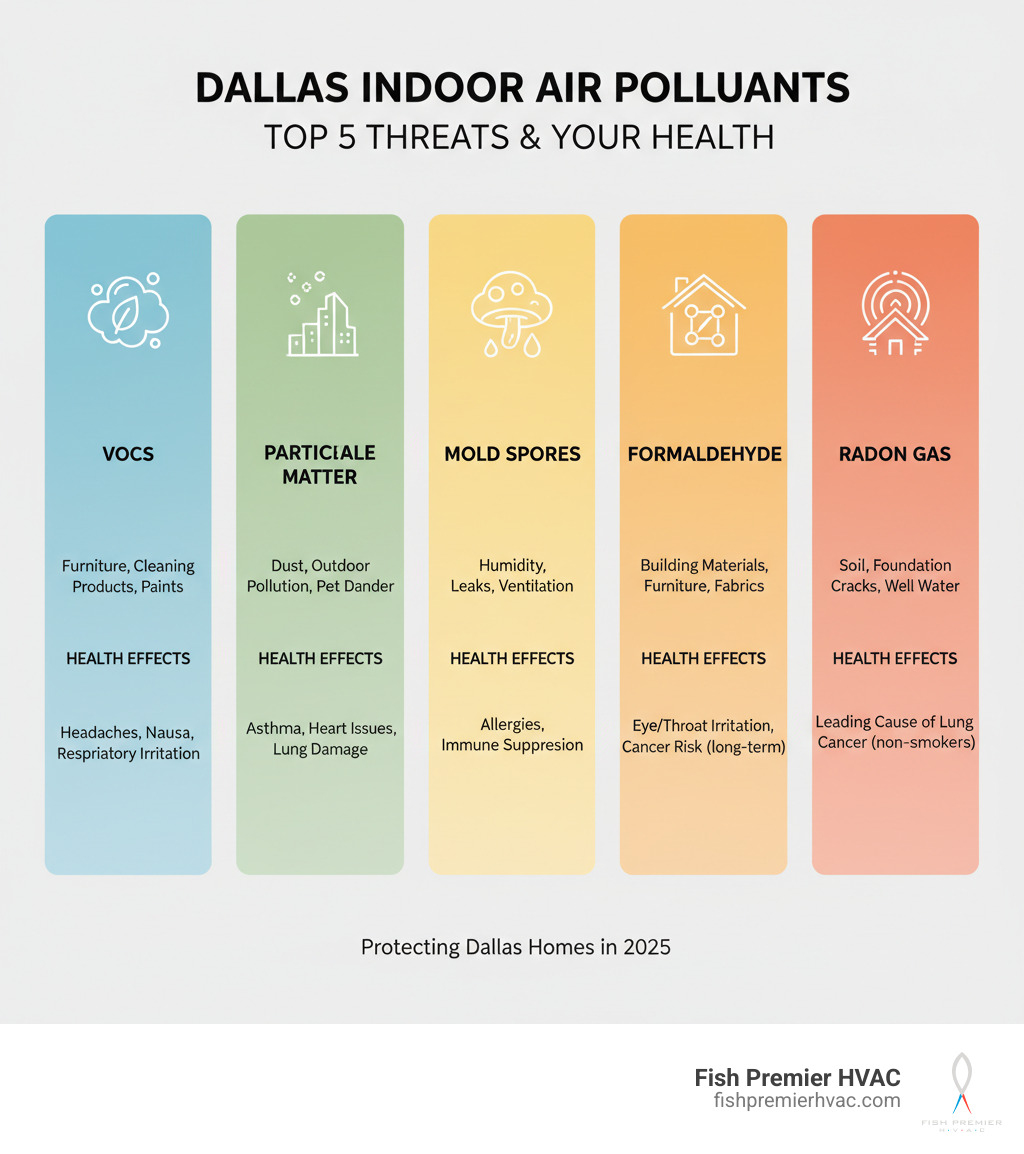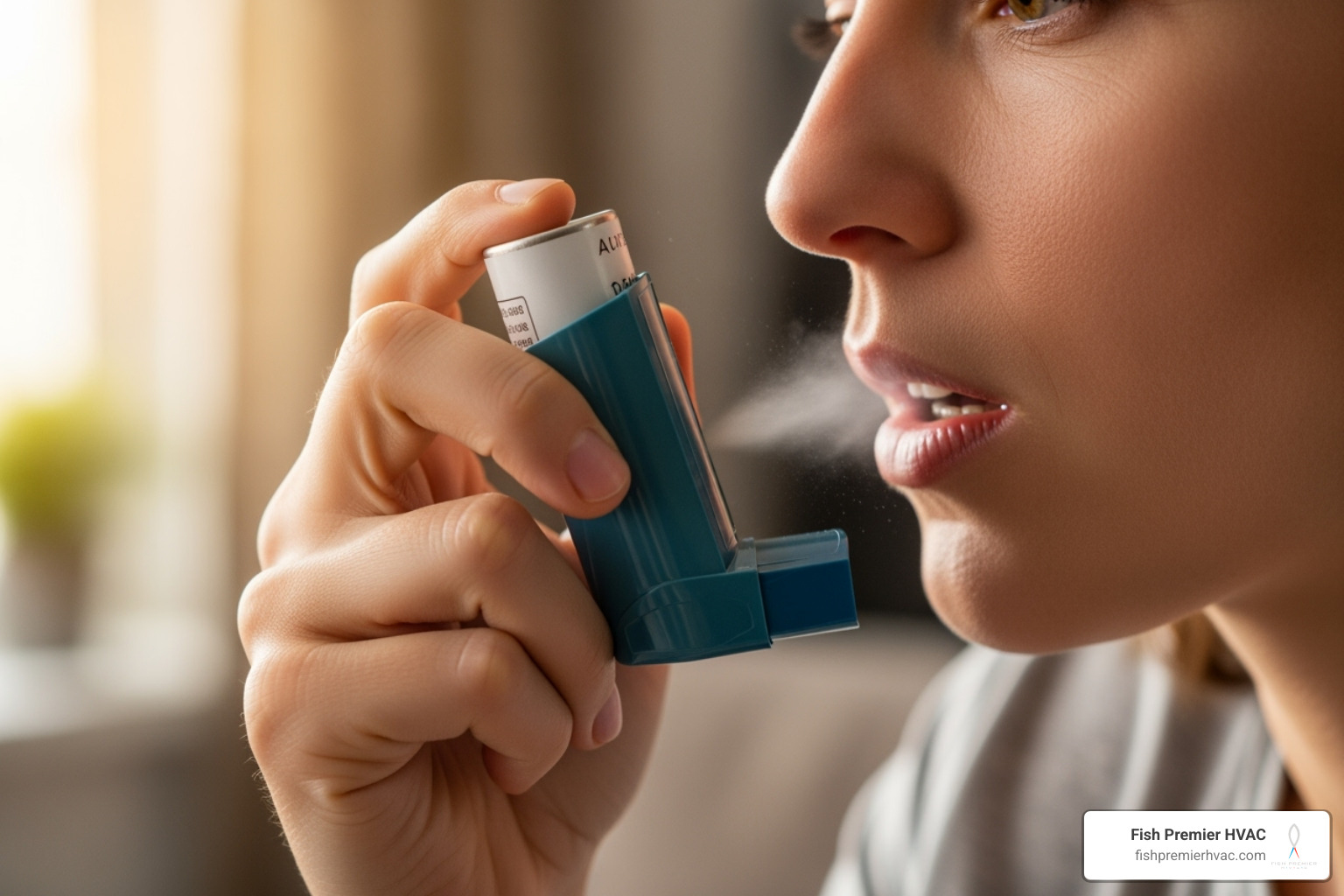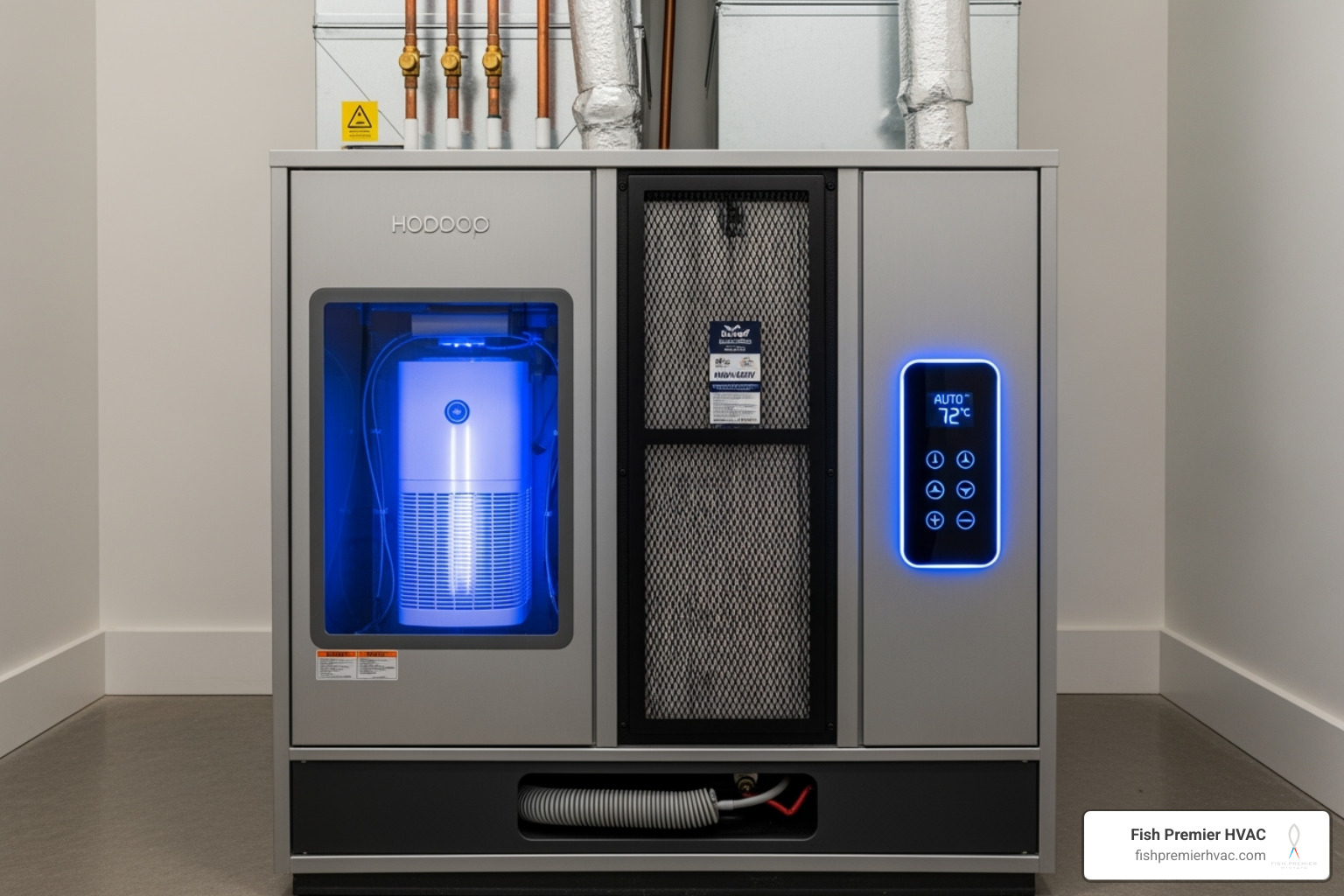Clear Skies Indoors: Elevating Your Dallas Home's Air Quality
Breathe easier in Dallas! Combat pollution & boost your home's indoor air quality Dallas with expert tips & advanced solutions.
Why Dallas Homeowners Can't Ignore Indoor Air Quality
Indoor air quality Dallas homes face unique challenges. Since the average American spends 90 percent of their time indoors, the air inside your home is more critical to your health than you might think.
Quick Solutions for Better Indoor Air Quality in Dallas:
- Monitor your air - Use smart air quality monitors to track PM2.5, VOCs, and CO2 levels
- Upgrade your HVAC filters - Install MERV 13 or higher filters and change them every 30-90 days
- Control humidity - Maintain 30-50% humidity to prevent mold growth
- Professional maintenance - Schedule annual HVAC inspections and air duct cleaning
- Add air purification - Install whole-house UV sanitizers and air scrubbers
Dallas faces a perfect storm for poor indoor air quality due to industrial growth and a population of 7.6 million. This growth brings outdoor pollution that seeps into your home.
Shockingly, indoor air can be 2 to 5 times more polluted than outdoor air. Your Dallas home might harbor invisible threats like VOCs from new furniture, formaldehyde from building materials, and microscopic particles that can enter your bloodstream.
The good news is you have control over your indoor environment. With the right knowledge and premium solutions, you can create a sanctuary of clean air for your family's health and comfort.

The Dallas Dilemma: Why Your Home's Air is a Health Concern
Living in Dallas means being part of a booming metroplex, but this growth presents an invisible challenge. The Dallas-Fort Worth industrial market continues to grow, leading to more factories, traffic, and pollutants. These outdoor contaminants find their way inside, mixing with pollutants your home generates on its own.
Your home can act like a sponge, absorbing outdoor pollution while creating its own, a double hit most homeowners don't realize they face daily.
How Dallas's Outdoor Air Invades Your Home
The American Lung Association reported in 2023 that the Dallas-Fort Worth metro ranked 18th out of 227 metro areas for high ozone days, placing us in the top 10% for poor air quality.
Ozone pollution forms when sunshine mixes with emissions from cars and industry. When you open a door, particulate matter (PM2.5) from vehicle exhaust and construction also drifts inside. These particles are so tiny that particulate matter can enter the bloodstream and impair lung function, making them particularly dangerous. Traffic and industry also add nitrogen oxides and sulfur dioxide, which your HVAC system can pull inside, contributing to your indoor air quality Dallas challenge.
Common Pollutants Lurking in Dallas Homes
Even without outdoor pollution, your home generates its own air quality problems. These are common culprits:
- Volatile Organic Compounds (VOCs): These chemicals off-gas from new furniture, cleaning products, and fresh paint. Indoor VOC levels can be up to ten times higher than outdoors.
- Formaldehyde: Found in particleboard furniture, cabinets, and carpeting, it can cause eye and throat irritation and poses long-term health risks.
- Pesticides: Indoor pesticide use can account for 80% of a person's exposure, with chemicals lingering in the air for months.
- Radon: This invisible, odorless radioactive gas seeps from the ground through foundation cracks. Dallas and Denton Counties have higher levels, making testing important.
- Mold: Our Texas humidity allows mold to thrive in damp areas like bathrooms, releasing spores that trigger allergies and respiratory issues.
- Dust mites and pet dander: These common allergens settle into carpets and upholstery, becoming a constant source of airborne particles.
- Combustion pollutants: Gas stoves and improperly maintained furnaces can release carbon monoxide and nitrogen dioxide. Asbestos is also a concern in older homes during renovations.
Understanding these challenges is the first step toward creating cleaner, healthier air in your home.
Health Under Siege: The Risks of Poor Indoor Air Quality
When pollutants accumulate indoors, the air you breathe can undermine your health. Poor indoor air quality Dallas residents experience can trigger issues from daily annoyances to serious conditions. Many people don't connect symptoms like persistent headaches, fatigue, or worsening allergies to their indoor environment.

From Allergies to Asthma: Common Health Reactions
Your body often signals poor air quality through allergic reactions like sneezing, a runny nose, or itchy, watery eyes. These are triggered by dust mites, pet dander, mold spores, and pollen.
Respiratory problems like persistent coughing, wheezing, or shortness of breath are also red flags. For those with allergies or asthma, poor indoor air can worsen their conditions. This is especially concerning because tiny particulate matter can enter the bloodstream and impair lung function, affecting your cardiovascular system. Other common symptoms include headaches, fatigue, dizziness, and difficulty concentrating.
Understanding Environmental Illnesses and Chemical Sensitivities
For some, poor indoor air leads to more serious environmental illnesses.
- Mold sensitivity: Common in Dallas, an overreaction to mold spores can cause chronic sinus problems, skin irritation, or neurological symptoms like brain fog.
- Multiple Chemical Sensitivity (MCS): This involves adverse reactions to low levels of everyday chemicals (VOCs), triggering severe headaches, fatigue, nausea, and breathing difficulties.
- Sick Building Syndrome (SBS): This occurs when you feel unwell only in a specific building, like your home, with symptoms that improve when you leave.
Long-term exposure risks are the most serious concern, increasing the risk of cardiovascular disease, neurological problems, and certain cancers (like lung cancer from radon). Understanding these risks empowers you to take action and protect your family's health.
Your Action Plan for Cleaner Air: Monitoring and DIY Solutions
You have more control over your indoor air quality Dallas than you might think. While we can't change the outdoors, we can transform our homes. Here's a practical, step-by-step approach to help you breathe easier.

Step 1: Monitor Your Air
You can't improve what you can't see. Measuring invisible pollutants is the first step. Modern smart monitors with app integration make this simple, tracking PM2.5 particles, VOCs, and carbon dioxide levels. Your phone becomes an air quality command center, alerting you when to ventilate or investigate a problem.
Step 2: Practical Tips for a Cleaner Home Environment
Your cleaning routine is your first line of defense. Focus on making the air clean, not just making things look clean.
- Dust and vacuum regularly with HEPA filters to trap microscopic particles like dust mites and pet dander.
- Avoid synthetic air fresheners, which add harmful chemicals to your air. Eliminate odor sources and use proper ventilation instead.
- Use exhaust fans in bathrooms and kitchens to pull out moisture and cooking fumes. Proper ventilation strategies also include opening windows when outdoor air quality is good.
Step 3: Using Nature's Air Purifiers
Adding the right plants creates living air filters. Plants can detoxify the air you breathe and beautify your space.
- Snake Plant: Ideal for bedrooms, this hardy plant releases oxygen at night.
- Peace Lily: An neat plant that is excellent at filtering VOCs. Keep away from pets and children.
- English Ivy: A powerhouse for removing airborne toxins.
Step 4: Balancing Humidity in the Dallas Climate
Getting humidity right is crucial for indoor air quality Dallas homes need. During our humid summers, excess moisture helps mold grow. Keeping humidity between 30-50 percent prevents this and makes your home feel cooler.
- Dehumidifiers for humid summers: Integrated with your HVAC, these pull excess moisture from your air, maintaining ideal levels throughout your home.
- Humidifiers for dry winters: When humidity drops, these add moisture back to prevent dry skin and scratchy throats.
Finding this balance keeps your family comfortable and helps control mold and dust mites.
Advanced Solutions for Superior Indoor Air Quality in Dallas
While DIY steps help, achieving exceptional indoor air quality Dallas homes deserve often requires professional-grade solutions. Equipping your HVAC system, your home's respiratory system, with advanced air purification technology is a powerful way to create the cleanest possible indoor environment.

The Heart of Your Home: HVAC Maintenance and Filtration
Your HVAC system is your greatest asset in maintaining clean air. The key is proper maintenance and filtration.
- Annual HVAC check-ups: A qualified technician will inspect components, clean coils that can harbor bacteria, and ensure proper airflow to prevent pollutant buildup.
- High-MERV Filters: MERV ratings indicate how well a filter captures particles. MERV 13 filters can capture microscopic particles like pollen, pet dander, mold spores, and even some bacteria and viruses.
- Regular Filter Changes: A clogged filter is useless. Changing filters regularly (every 30-90 days) is crucial, especially in homes with pets, smokers, or allergy sufferers.
Upgrading Your System for Premier Indoor Air Quality in Dallas
For premium air quality, consider these advanced technologies:
- Whole-house air purification systems: These integrate into your ductwork, providing professional-grade purification for your entire home, whether you're in Southlake, Keller, or elsewhere in the DFW area.
- UV air sanitizers: Using the same technology as hospitals, these systems use ultraviolet light in your ducts to neutralize bacteria, viruses, and mold spores.
- Air scrubbers: These systems go a step further by actively sending cleansing ions throughout your home to clean the air and reduce contaminants on surfaces.
- HVAC scent diffusers: For a touch of luxury, these systems infuse your home with high-quality fragrances through your HVAC system, creating a pleasant and pristine environment.
Professional Services for a Deeper Clean in Dallas
Sometimes, a deeper clean is needed to address existing contamination.
- Air duct cleaning: Recommended every 3-5 years, this service removes accumulated dust and dander from your ductwork, improving efficiency and preventing recirculation of old contaminants.
- Professional mold remediation: Critical for established mold growth, this service addresses the root cause of moisture and uses specialized techniques to ensure mold doesn't return.
Working with certified technicians is essential. They understand how to integrate these solutions with your HVAC system for optimal performance.
Beyond Your Four Walls: Community Action and Dallas Regulations
Improving indoor air quality Dallas homes enjoy is a community effort. Working together extends the benefits beyond your four walls and across the metroplex.
Dallas Community Initiatives and Resources
Several city programs work to improve our air:
- Air North Texas: A leader in building awareness, offering practical resources and education for cleaner air.
- Dallas Community Air Management Program: Provides data-driven air quality information to help residents make informed decisions about ventilation.
- Clean Air Action Day: A community-wide event each June encouraging simple actions to reduce air pollution.
Understanding Dallas Green Building Clearance (Ordinance 804.2)
For new construction or major renovations, Dallas has forward-thinking regulations. Ordinance 804.2 for Post Construction & Pre-Occupancy Baseline IAQ Testing requires buildings to meet specific IAQ standards before receiving a Certificate of Occupancy. This means Total Volatile Organic Compound (TVOC) levels must be less than 500 micrograms per cubic meter.
This ensures construction materials have properly off-gassed before you move in, minimizing chemical exposure. You can find more details in the Dallas Green Building Code.
How You Can Advocate for Cleaner Air
Everyone can make a difference. Reduce personal emissions by carpooling, using public transit, or combining trips. Consider upgrading to electric lawn equipment and energy-efficient appliances.
For greater involvement, contact local officials. The Dallas Office of Environmental Quality & Sustainability and your city council member want to hear from constituents who care about clean air. Combining home IAQ systems with community efforts creates the best environment for your family.
Frequently Asked Questions about Indoor Air Quality in Dallas
How often should I change my HVAC filter in Dallas?
For optimal indoor air quality Dallas, changing your HVAC filter is crucial, but the frequency depends on several factors:
- Filter Type: Basic MERV 8-10 filters usually need replacement every 30 days. Higher-efficiency MERV 11-13 filters can last 60-90 days.
- Household Factors: Homes with pets, smokers, or allergy sufferers should change filters more frequently, around every 30-45 days.
- HVAC Usage: During Dallas's hot summers and cold winters, your system runs more, clogging filters faster. Check your filter monthly.
A good rule of thumb is to replace your filter every 30-90 days. If you hold it up to a light and can't see through it, it's time for a change. A dirty filter harms air quality and drives up energy bills by forcing your system to work harder.
What are the first signs of a mold problem in a home?
Catching mold early can prevent serious health issues and costly remediation. Here are the primary warning signs:
- A Musty Smell: A persistent damp, earthy odor, especially in bathrooms or basements, is often the first clue that mold is growing, even if it's not visible.
- Visible Growth: Look for white, green, orange, or brown spots or patches. Mold can appear fuzzy or like a stain on walls, ceilings, or around windows.
- Signs of Water Damage: Stains on ceilings, warped baseboards, or peeling paint indicate moisture problems, which are a breeding ground for mold.
- Unexplained Health Symptoms: If family members experience new or worsening sneezing, runny noses, itchy eyes, or coughing at home, mold could be the trigger.
- High Humidity: A home that consistently feels damp (humidity above 60%) creates a perfect environment for mold. This is why humidity control is vital for healthy indoor air quality Dallas homes need.
If you notice these signs, address the potential mold issue promptly.
Conclusion: Take Control of Your Home's Atmosphere
Living in Dallas presents unique air quality challenges from industrial growth and outdoor pollution that impact your home. The empowering truth is that you have far more control over your indoor air quality Dallas than you might think. Every step, from monitoring your air to upgrading HVAC filters, makes a real difference in your family's health and comfort.
The journey to cleaner air begins with understanding what you're breathing and implementing practical solutions. For homeowners who want the best, advanced systems can transform your home into a sanctuary. Whole-house air purification systems, UV sanitizers, and air scrubbers are essential tools for serious indoor air quality Dallas protection.
At Fish Premier HVAC, we believe your home should be your refuge. We provide concierge-level service, offering luxury, comfort, and premium solutions to lift your home environment to a new standard of excellence.
Your family deserves to breathe easy. The air quality challenges in Dallas are real, but so are the solutions. Take the first step toward changing your home's atmosphere today.
For a comprehensive assessment and premium solutions to lift your home's environment, explore our air purification services.




%201.avif)


.svg)
.svg)
.svg)









